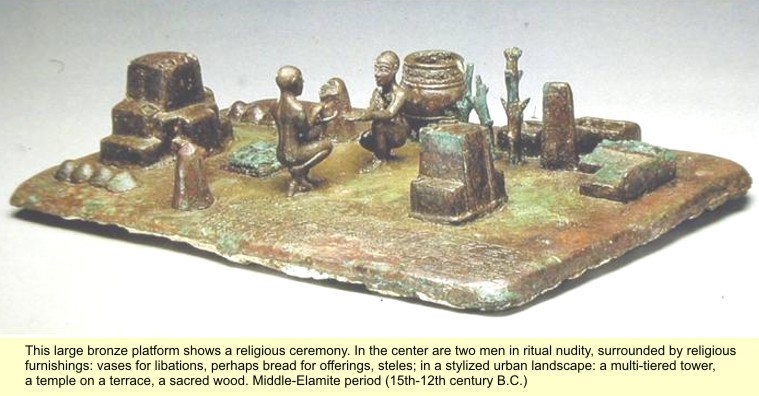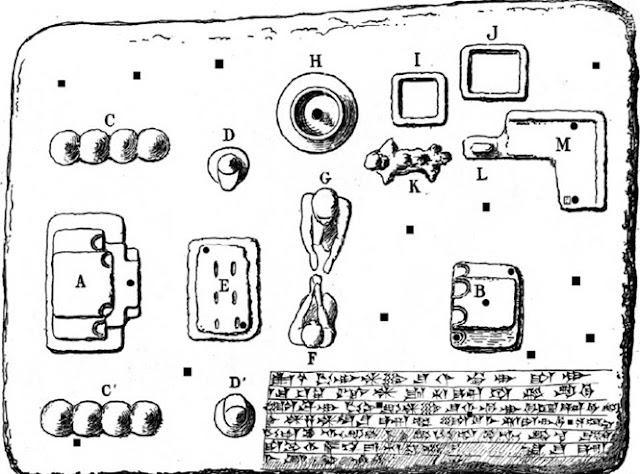This is an addendum to:
1. Prayer postures on Indus Script Corpora and kole.l 'smithy,forge' as kole.l 'temple' -- Indian sprachbund, 'speech union' http://tinyurl.com/y4rwd86n
2. Indus Script hypertexts which signify pattar an artificer guild praying to Pitr̥ with जानु+ दक्षिणतः+आ* च्य 'with the right knee bent' (RV 10.15.6) https://tinyurl.com/y4qncu6c
The following inscriptions show worshippers with bent knee as specified in the R̥gveda R̥ca I had cited. The prayer is to Pitr̥,’ancestors’. (Sources for these pictures have been provided in the two monographs cited above)..
Comparable prayer posture is seen on Sit Shamshi Bronze (Louvre Museum) which narrates in an Akkadian Elamite inscription: "I Shilhak-Inshushinak, son of Shutruk-Nahhunte, beloved servant of Inshushinak, king of Anshan and Susa [...], I made a bronze sunrise."
The two adorants offering water ablutions in front of the ziggurat (which is a temple) are seated in the same prayer posture as depicted on Indus Scrpt Corpora.
See:
1. Sit Shamshi bronze and Susa table with overflowing pots signify Indus Script hypertexts veneration of sun, ancestors, metalwork wealth creation https://tinyurl.com/yam8ccv8
2. Sit Shamshi bronze, morning libations to Sun divinity, as Meluhha metalwork with Indus writing hieroglyphs transmitted along the Tin Road of Antiquityhttp://bharatkalyan97.blogspot.com/2015/01/sit-shamshi-bronze-morning-libations-to.html
3. Susa Sit Shamshi 'sunrise' is Vedic काण्डर्षि.tarpaṇam, purification by water & the Sun, veneration of ancestors http://tinyurl.com/qdny4v7
The Sit Shamshi bronze model parallels the libations practised from ancient times by Hindus, Meluhha speakers who called themselves, bharatiyo 'metal casters' (Gujarati). The prayers are called sandhyā vandanam which is perhaps the oldest practice among world religions. [quote]Sandhyavandanam consists of excerpts from the Vedas that are to be performed thrice daily at morning (prātaḥsaṃdhyā), at noon (mādhyānika), and in the evening (sāyaṃsaṃdhyā)...Sandhyāvandanam literally means salutation to Sandhya. Sandhya literally means transition moments of the day namely the two twilights : dawn and dusk and the solar noon. Thus Sandhyavandanam means salutation to twilight or solar noon. The term saṃdhyā is also used by itself in the sense of "daily practice" to refer to the performance of these devotions at the opening and closing of the day. For saṃdhyā as juncture of the two divisions of the day (morning and evening) and also defined as "the religious acts performed by Brahmans and twice-born men at the above three divisions of the day" see Monier-Williams, p. 1145, middle column.[unquote]
The Elamite/Akkadian word ‘shamshi’ which signifies ‘sunrise’ is cognate with अशीतिःN. of the four passages of the sun from one zodiacal sign to the other. शोषयित्नुः [शुष्-इत्नुच् Uṇ.3.29] The sun.शोषिणी Ether. Fire; the semantics are traceable to R̥gveda:
षष् num. a. (used in pl., nom.षट्; gen. षण्णाम्) Six; तेषांत्ववयवान्सूक्ष्मान्षण्णामप्यमितौजसाम् Ms.1.16;8.43. अशीतिः f. (-ष़डशीतिः) 1 eighty-six. -2 N. of the four passages of the sun from one zodiacal sign to the other. शोषयित्नुः [शुष्-इत्नुच् Uṇ.3.29] The sun.शोषिणी Ether. Fire; शुचि a. [शुच्-कि] 1 Clean, pure, clear; the sun शुचीनांहृदयंशुचिः Mb.12.193.18. शाश्वत a. (-ती f.) 1 [शश्वद्भवःअण्] 1 Eternal, per- petual, everlasting; शाश्वतीःसमाः Rām.1.2.15 (= U.2. 5) 'for eternal years', 'ever more', 'for all time to come'; श्रेयसेशाश्वतोदेवोवराहःपरिकल्पताम् U.5.27 (v. l.); R.14.14. -2 All. -तः 1 N. of Śiva. -2 Of Vyāsa. -3 The sun.
Sit Shamshi discovered in the area of the Ninhursag temple, Susa(After Plate 7.21 DT Potts, 2015, Archaeology of Elam, Cambridge University Press) Photo: Dr. JavierAlvarez-Mon).


